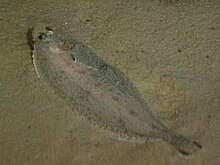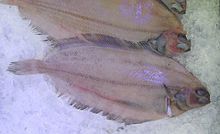Witch (righteye flounder)
| Witch | |
|---|---|

| |
| Scientific classification | |
| Domain: | Eukaryota |
| Kingdom: | Animalia |
| Phylum: | Chordata |
| Class: | Actinopterygii |
| Order: | Pleuronectiformes |
| Family: | Pleuronectidae |
| Genus: | Glyptocephalus |
| Species: | G. cynoglossus
|
| Binomial name | |
| Glyptocephalus cynoglossus | |
| Synonyms[2] | |
The witch (Glyptocephalus cynoglossus), known in English by a variety of other common names including the witch flounder, pole flounder, craig fluke, Torbay sole, and grey sole, is a species of flatfish from the family Pleuronectidae. It occurs on both sides of the North Atlantic Ocean on muddy sea beds in quite deep water. In northern Europe it has some importance in fisheries as a food fish.
Description
The witch is a
Distribution
The witch occurs on both sides of the North Atlantic Ocean. In the northeastern Atlantic Ocean it is found from the northernmost part of the
Habitat
Witch adults are found on the
Biology
The witch feeds on invertebrates and in European waters the main prey items are small crustaceans, starfish, small molluscs, and worms. Fish are rarely taken, if at all, and it does not take baits.[3] Spawning occurs between May and September.[4] and can take place in temperatures ranging from near freezing to 8.8-10 °C, experiments have demonstrated that the eggs continue to incubate normally in water which is as cold as 7.2 °C (45.0 °F). and as warm as 12.77 °C (54.99 °F).[3] The eggs take around a week to hatch, the newly hatched
Fisheries

The witch is commercially important as a bycatch and there are fisheries directed at this species, except that it is occasionally targeted in the Skagerrak. It is an important bycatch species in some fisheries which target the langoustine (

References
- . Retrieved 9 December 2022.
- ^ a b Froese, Rainer; Pauly, Daniel (eds.) (2018). "Glyptocephalus cynoglossus" in FishBase. February 2018 version.
- ^ a b c d e f g h i j Henry B. Bigelow & William C. Schroeder (1953). "Witch flounder Glyptocephalus cynoglossus (Linnaeus) 1758". Fishes of the Gulf of Maine. Vol. 53. United States Department of the Interior Fish and Wildlife Service. Retrieved 24 March 2018.
{{cite book}}:|journal=ignored (help) - ^ a b c d e f g h i j k "Glyptocephalus cynoglossus (Linnaeus, 1758)". Species Fact Sheets. Food and Agriculture Organization of the United Nations Fisheries and Aquaculture Department. Retrieved 24 March 2018.
- ^ a b c d "Witch Flounder". Fisheries and Oceans Canada. 2016-12-19. Retrieved 24 March 2018.
- ^ a b c J.C. Hureau. "Fishes of the NE Atlantic and the Mediterranean". Marine Species Identification Portal. ETI Bioinformatics. p. Witch (Glyptocephalus cynoglossus). Retrieved 24 March 2018.
- ^ a b c d e Monroe, T.; Costa, M.; Nielsen, J.; Herrera, J. & de Sola, L. (2015). "Glyptocephalus cynoglossus (Europe assessment)". IUCN Red List of Threatened Species. 2015: e.T18214757A45790104. Retrieved 23 March 2018.
- ^ "Glyptocephalus cynoglossus". NatureServe Explorer An online encyclopedia of life. 7.1. NatureServe. Retrieved 11 August 2023.
- . Abstract
- doi:10.2960/J.v12.a2.
- ^ a b c "Witch". British Seafishing. 31 August 2012. Retrieved 24 March 2018.
- ^ Witch | InterSites

